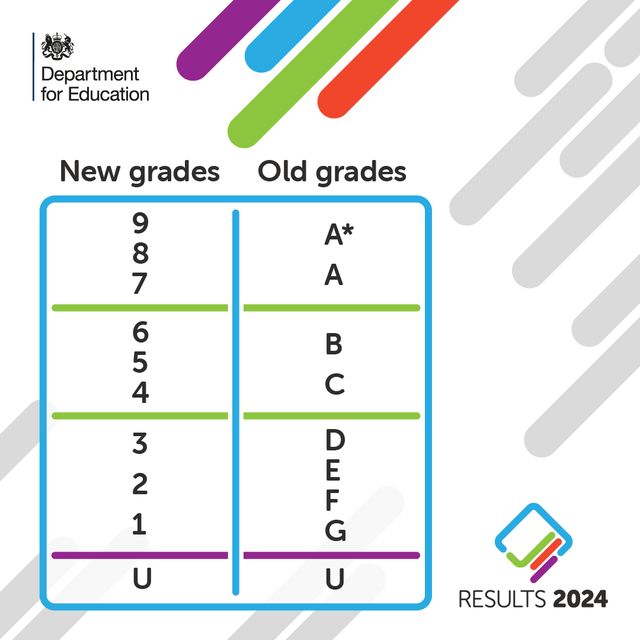
Picture: Pixel art portrayal by WigTea, illustrating a diverse group of students receiving their GCSE results in 2024. The image beautifully captures a range of emotions, reflecting both the triumphs and challenges faced by students in this critical moment.
The UK’s GCSE grades continue to show strength, but disparities underscore urgent challenges
The GCSE (General Certificate of Secondary Education) results for 2024 mark a significant moment for students across the UK, reflecting both the ongoing impacts of the pandemic and the broader challenges within the education system. This year’s outcomes provide a mixture of continuity with recent trends and highlight key areas of concern, particularly regarding educational disparities.
Grading trends and comparisons
The overall GCSE performance in 2024 presents a nuanced picture. Approximately 21.8% of entries were awarded grades 7/A or above, a slight decrease from 22% in 2023 but still above the pre-pandemic level of 20.8% in 2019. This minor decline suggests that the post-pandemic recalibration of grading standards, which began last year, is continuing. The shift towards normalisation, however, has been gradual, with this year’s figures still showing elevated performance compared to pre-COVID years.
The proportion of students achieving a standard pass (grade 4/C or above) also saw a minor decline, dropping from 68.2% in 2023 to 67.6% in 2024. Although this decrease might raise concerns, it is essential to note that the 2024 figure remains higher than the 67.3% recorded in 2019, indicating that students’ overall performance is still strong despite the challenges posed by the pandemic.
What do the number grades mean?
The grades are ranked from 1, the lowest, to 9, the highest. The grades don’t exactly translate, but the two grading scales meet at three points as illustrated below.
The bottom of grade 7 is aligned with the bottom of grade A, while the bottom of grade 4 is aligned to the bottom of grade C. Meanwhile, the bottom of grade 1 is aligned to the bottom of grade G.

Picture: Comparison between the new GCSE number grading system (introduced in England) and the old letter grading system. Source: Department for Education
Subject-specific outcomes
The performance across different subjects reveals some interesting trends. Science subjects, often perceived as challenging, have shown modest improvements in top grades. For instance, 8.8% of students in double science secured grades 7/A or higher, a slight increase from 8.5% in 2023. Individual sciences like chemistry, physics, and biology also saw stable or improved results, which may reflect ongoing support measures such as formulae and equation sheets provided to students as a concession to the learning disruptions caused by the pandemic.
In modern foreign languages, particularly German and French, there have been notable improvements in top grades due to adjustments in grading standards aimed at aligning these subjects with Spanish. In German, 32.1% of students achieved a grade 7/A or above, a significant increase from 27.6% in 2023. This adjustment highlights efforts to ensure fairness and consistency across subjects, which has been a critical focus for exam boards this year.
Gender and regional disparities
Gender disparities continue to be a significant feature of GCSE results. In 2024, 25.5% of grades awarded to girls were 7/A or above, compared to 19.8% for boys. This gender gap, although slightly narrower than in previous years, remains substantial and underscores the need for targeted interventions to support boys’ educational attainment.
Regional disparities also persist, with London and the South East leading the country in terms of top grades. Over a quarter of entries in these regions achieved at least a grade 7, while the North East lagged behind with only 17.8% reaching the same level. Although the gap between the highest and lowest-performing regions has narrowed slightly from 10.8 percentage points in 2023 to 10.7 in 2024, these figures reflect ongoing challenges in balancing educational outcomes across the country.
Socioeconomic factors and educational inequality
The 2024 results further underscore the significant role that socioeconomic factors play in educational outcomes. The disparity between private and state schools, particularly in terms of top grades, has widened. Nearly half (48.4%) of private school entries were awarded grades 7 or above, compared to just 19.4% in comprehensive schools. This 29 percentage point gap, up slightly from last year, highlights the persistent inequalities within the education system.
This widening gap is concerning, as it suggests that despite efforts to level the playing field, socioeconomic status continues to heavily influence academic achievement. The gap between private and state schools not only reflects differences in resources and support but also indicates broader systemic issues that need to be addressed. The education sector, along with policymakers, must prioritise measures that target these inequalities, such as increased funding for underperforming regions, more support for state schools, and initiatives aimed at closing the gender gap in academic performance.
Conclusion
The 2024 GCSE results provide a mixed but insightful snapshot of the current state of secondary education in the UK. While the overall performance remains strong compared to pre-pandemic levels, the slight decline in top grades and pass rates suggests a return to more typical grading standards. However, the persistence of significant gender, regional, and socioeconomic disparities indicates that much work remains to be done to ensure that all students have equal opportunities to succeed.
To address these disparities, targeted interventions are needed. These might include increased funding for schools in disadvantaged areas, programmes to support boys’ academic achievement, and continued efforts to standardise grading across subjects. As the UK continues to recover from the pandemic, the focus must remain on creating an education system that is fair, equitable, and capable of supporting all students, regardless of their background.
By addressing these issues, the education sector can help ensure that future GCSE results reflect not just the hard work of students and teachers but also the success of a system that truly supports every learner.

Leave a Reply